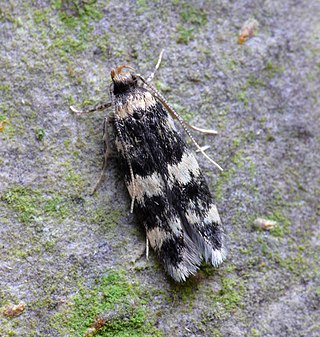Related Research Articles

A demon is a malevolent supernatural entity. Historically, belief in demons, or stories about demons, occurs in religion, occultism, literature, fiction, mythology, and folklore; as well as in media such as comics, video games, movies, and television series.

Moths are a group of insects that includes all members of the order Lepidoptera that are not butterflies. They were previously classified as suborder Heterocera, but the group is paraphyletic with respect to butterflies and neither subordinate taxa are used in modern classifications. Moths make up the vast majority of the order. There are thought to be approximately 160,000 species of moth, many of which have yet to be described. Most species of moth are nocturnal, although there are also crepuscular and diurnal species.
Mastema, or Mansemat, is the demon who appears in the Book of Jubilees. He pleads with God to permit the spirits of the dead Nephilim remain on the planet Earth, so they can corrupt and lead men astray prior to judgement. Because there was great wickedness in men, God condemned all the demons to descend into condemnation except for a tenth who could remain.

The Sphingidae are a family of moths commonly called sphinx moths, also colloquially known as hawk moths, with many of their caterpillars known as "hornworms"; it includes about 1,450 species. It is best represented in the tropics, but species are found in every region. They are moderate to large in size and are distinguished among moths for their agile and sustained flying ability, similar enough to that of hummingbirds as to be reliably mistaken for them. Their narrow wings and streamlined abdomens are adaptations for rapid flight. The family was named by French zoologist Pierre André Latreille in 1802.

The Arctiinae are a large and diverse subfamily of moths with around 11,000 species found all over the world, including 6,000 neotropical species. This subfamily includes the groups commonly known as tiger moths, which usually have bright colours, footmen, which are usually much drabber, lichen moths, and wasp moths. Many species have "hairy" caterpillars that are popularly known as woolly bears or woolly worms. The scientific name Arctiinae refers to this hairiness. Some species within the Arctiinae have the word "tussock"' in their common names because they have been misidentified as members of the Lymantriinae subfamily based on the characteristics of the larvae.

Oecophoridae is a family of small moths in the superfamily Gelechioidea. The phylogeny and systematics of gelechoid moths are still not fully resolved, and the circumscription of the Oecophoridae is strongly affected by this.

The Elachistidae are a family of small moths in the superfamily Gelechioidea. Some authors lump about 3,300 species in eight subfamilies here, but this arrangement almost certainly results in a massively paraphyletic and completely unnatural assemblage, united merely by symplesiomorphies retained from the first gelechioid moths.

The Gelechiidae are a family of moths commonly referred to as twirler moths or gelechiid moths. They are the namesake family of the huge and little-studied superfamily Gelechioidea, and the family's taxonomy has been subject to considerable dispute. These are generally very small moths with narrow, fringed wings. The larvae of most species feed internally on various parts of their host plants, sometimes causing galls. Douglas-fir (Pseudotsuga) is a host plant common to many species of the family, particularly of the genus Chionodes, which as a result is more diverse in North America than usual for Gelechioidea.

Crambidae comprises the grass moth family of lepidopterans. They are variable in appearance, with the nominal subfamily Crambinae taking up closely folded postures on grass stems where they are inconspicuous, while other subfamilies include brightly coloured and patterned insects that rest in wing-spread attitudes.

Notodontidae is a family of moths with approximately 3,800 known species. The family was described by James Francis Stephens in 1829. Moths of this family are found in all parts of the world, but they are most concentrated in tropical areas, especially in the New World.

The Pyraloidea are a moth superfamily containing about 16,000 described species worldwide, and probably at least as many more remain to be described. They are generally fairly small moths, and as such, they have been traditionally associated with the paraphyletic Microlepidoptera.

Vittorio the Vampire (1999) is a vampire novel by American writer Anne Rice. It is one of two novels in the New Tales of the Vampires series, along with Pandora.

The Blastobasidae are a family of moths in the superfamily Gelechioidea. Its species can be found almost anywhere in the world, though in some places they are not native but introduced by humans. In some arrangements, these moths are included in the case-bearer family (Coleophoridae) as subfamily Blastobasinae. The Symmocidae are sometimes included in the Blastobasidae as subfamily or tribe.

Azazel: Book of Angels Volume 2 is an album by the Masada String Trio performing compositions from John Zorn's second Masada book, "The Book of Angels".

The Erebidae are a family of moths in the superfamily Noctuoidea. The family is among the largest families of moths by species count and contains a wide variety of well-known macromoth groups. The family includes the underwings (Catocala); litter moths (Herminiinae); tiger, lichen, and wasp moths (Arctiinae); tussock moths (Lymantriinae), including the arctic woolly bear moth ; piercing moths ; micronoctuoid moths (Micronoctuini); snout moths (Hypeninae); and zales, though many of these common names can also refer to moths outside the Erebidae. Some of the erebid moths are called owlets.

In the Hebrew Bible, the destroying angel, also known as mashḥit, is an entity sent out by YHWH on several occasions to kill the enemies of the Hebrews.
Mastema occidentalis is a moth in the family Blastobasidae. It is found in Arizona, United States.

Autostichidae is a family of moths in the moth superfamily Gelechioidea.

Mobile Suit Gundam: Twilight AXIS is a Japanese light novel series written by Kōjirō Nakamura and illustrated by ARK Performance, released by Sunrise under the Yatate Bunko imprint. It is the second Gundam media to feature a main female protagonist after Mobile Suit Gundam École du Ciel. Set after the events of Mobile Suit Gundam Unicorn and before the events of Mobile Suit Gundam F91, in which it focuses on two former Zeon remnants as they were hired to investigate the remains of the asteroid base Axis. The novel is loosely based on Richard Wagner's opera Tristan und Isolde.

Jeanelle Mastema is a Mexican American experimental body and performance artist from Boyle Heights, California. Mastema incorporates ritual into her work through play piercing, hook suspensions, live magick and sacred objects. She performs internationally, solo and in groups, often acting as a medium for group intentions or a symbolic altar for channeling energy. Through performance, Mastema enters into a meditative head space to disconnect from mundane consciousness. Her major influences include: Butoh, Kenneth Anger, Surrealism, Psychedelic Art, the Viena Actionists, Kembra Pfaher, Leonora Carrington and Alejandro Jodorowsky. She also works as the West Coast sales manager for an adult novelty toy store. She also worked at the Pleasure Chest for many years and is featured in a film called, Thank You Come Again, based on working there.